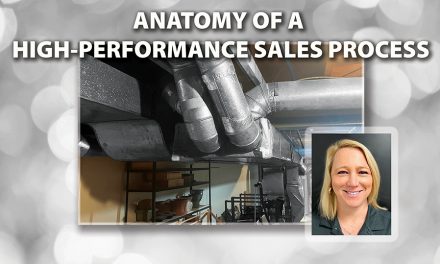It’s all about the process. We are a process-driven industry. We have processes for everything: how our CSRs answer the phones, how a technician handles a service call, how we do invoices, commissioning, installs, etc. How we approach IAQ is no different.
Through the years, I have developed a process for addressing customer IAQ needs: Investigate, Analyze, and Quote. You have to do all three, and you have to do them in order. Frequently, our industry goes right to the quote without fully understanding what’s happening in the space and its effects on occupants.
Investigate
The first step should be the investigation process or discovery phase. It’s during this phase that contractors go in and gather data. I start with sending a questionnaire to be filled out ahead of time. The answers to this questionnaire give me an idea of what direction to take the investigation. I take many pictures and always conduct a system performance test on the equipment.

More often than not, the HVAC system can have the biggest impact on the structure and its occupants. Getting information on delivered capacity, sensible latent ratios, airflow, static pressures, filtration rates, air exchanges per hour, and leaky ducts, is a fantastic start.
Then we move on to investigating the structure. Using a blower door allows us to identify pathways for pollutants to enter the structure. It is very important to know infiltration rates. We want to keep inside air in and outside air out. Air is the medium on which all things travel. One CFM in equals one CFM out.
Next, we need to measure and identify any pollutants in the space to “see the unseen.” Measuring and identifying such contaminants requires some specialty testing equipment. An AirAdvice.
IAQ monitoring instrument is a great entry-level tool for this purpose. By identifying what pollutants are in the space, we can also understand where they are coming from and how to get them under control.
Analyze
Having data is great, but we must understand that data compared to what the customer is experiencing. Examine your photos carefully. Review the customer’s questionnaire answers. At this point, things should start to make sense and become clear as to what direction you need to go.
Quote
We can now build our scope of work using the first two steps, investigate and analyze. This quote is customized for your client’s specific needs. The scope of work will usually be multi-tiered to address many different issues. Take the time to explain how each option works, what upkeep is involved, and how much it will cost to provide the various solutions.
At this point, you can advise the customer on whether to replace the equipment to support the options you are offering. With some training, practice, and experience, you are on the fast track to becoming an IAQ professional.
Six Key Principles
Here are six fundamental system performance principles we should already use in our everyday HVAC businesses. These are foundational principles to help quick-start you on your IAQ journey.
Cluck Below for the Next page:













Great Article John. Your five steps put the high-performance HVAC contractor at the center of improving IAQ.